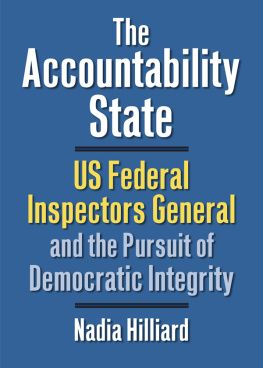Copyright 2020
THE BROOKINGS INSTITUTION
1775 Massachusetts Avenue, NW, Washington, D.C. 20036
www.brookings.edu
All rights reserved. No part of this publication may be reproduced or transmitted in any form or by any means without permission in writing from the Brookings Institution Press.
The Brookings Institution is a private nonprofit organization devoted to research, education, and publication on important issues of domestic and foreign policy. Its principal purpose is to bring the highest quality independent research and analysis to bear on current and emerging policy problems. Interpretations or conclusions in Brookings publications should be understood to be solely those of the authors.
Library of Congress Cataloging-in-Publication Data
Names: Johnson, Charles A., 1948, author. | Newcomer, Kathryn E., 1949 author.
Title: U.S. inspectors general : truth tellers in turbulent times / Charles A. Johnson, Kathryn E. Newcomer.
Description: Washington, D.C. : Brookings Institution Press, [2020] | Includes bibliographical references and index.
Identifiers: LCCN 2019026907 (print) | LCCN 2019026908 (ebook) | ISBN 9780815737773 (paperback) | ISBN 9780815737780 (epub)
Subjects: LCSH: Finance, PublicUnited StatesAuditing. | Governmental investigationsUnited States.
Classification: LCC HJ9801 .J63 2020 (print) | LCC HJ9801 (ebook) | DDC 331.7/6135235dc23
LC record available at https://lccn.loc.gov/2019026907
LC ebook record available at https://lccn.loc.gov/2019026908
9 8 7 6 5 4 3 2 1
Typeset in Adobe Jenson Pro
Composition by Elliott Beard
Foreword
In their scholarly and well-informed book U.S. Inspectors General: Truth Tellers in Turbulent Times , Professors Johnson and Newcomer provide a detailed accounting of how the federal inspector general (IG) community came to be, what its status is today, and where it might go from here. Their book is timely, since 2018 marked a critically important milestone year for the inspectors general: the fortieth anniversary of the Inspector General Act of 1978, which formally established the IG structure across government lines. President Carter, who signed the legislation into law on October 12, 1978, characterized it as perhaps the most important new tool in the fight against (government) fraud.
Recent events propel the institution as never before in its core mission of helping to promote public confidence in and understanding of federal government operations in general, and in the various agencies of government in particular. At this very moment, it is hard to scan a newspaper, tune into talk radio, surf the television networks (both traditional and cable), or engage in social media without prominent mention of current IG initiatives. The highly visible and impactful work of the inspectors general (IGs) at the Department of Justice, Veterans Administration, Department of Homeland Security, and Department of Defense, for example, is frequently front page, above the fold material. It seems that almost every day, the IGs are asked to bring their professional expertise to address new or evolving high-profile, controversial matters.
Surprisingly, even after four decades since the enactment of the IG statute, there is a striking lack of familiarity with the IG concept. Despite composite budgets that exceed $2 billion annually and staffing of over 13,000, the work of the IG community is little understood and, in fact, is often misunderstood. Citizens, the media, and even senior elected officials regularly pose fundamental questions about IG operations. What was the genesis of the IG Act? Under what authorities do they operate? How are IG offices structured and staffed? Are the products of IG work publicly available? What is the range of investigatory tools available to an IG in potential criminal matters? These questions and many others are addressed in a comprehensive way in Johnson and Newcomers book.
Relying on extensive data-gathering techniques, Johnson and Newcomer provide the reader with an insiders sense of what makes the IG world tick. The authors interviewed a broad cross-section of current IG leaders and staff at numerous federal agencies. As reflected in the books title, the result is an inside look at IG community operations, with an emphasis on aspects that are working well and those that need to be improved. The authors did not, however, limit their data-gathering efforts to those currently in the IG community. In fact, as part of their research, Johnson and Newcomer sought the views of former IG officials and a broad range of other stakeholders, both inside and outside government. Thus, the authors present a realistic view of the IG community, addressing the core elements of IG operations.
There are specific aspects of the book that are of particular importance for the reader. For example, Johnson and Newcomer emphasize the integral role of root cause analysis in the work of an IG. They conclude that if truly useful recommendations for corrective actions are to be provided to agency management, the IG must have a clear understanding of the root cause of the problem. And, the recommendations must address the root cause directly. The authors acknowledge that root cause determination is not always easy. But they recognize that resolving problems is at the core of the IG function and that root cause analysis is a vital part of this effort. I think that Johnson and Newcomer have it exactly right.
The authors explored system stressors that impact IG operations, in particular the challenges of maintaining IG independence and keeping Congress up to date on the current status of operations. These can be among the most significant barriers that IGs must overcome if they are to be successful. Regarding independence, Johnson and Newcomer define the independence concept as it applies to the IG world. They note that an IG who is or is seen to be impaired from an independence perspective cannot be effective. The authors recognize that agency leadership may desire a particular outcome, and that direct or indirect pressure can be applied to obtain such an outcome. Yet, IGs must resist such efforts if they are to maintain their independence. At the end of the day, an independent setting is essential if an IG report is to be viewed by all parties as being objective, impartial, and fair, as well as to serve as a catalyst for corrective action that will improve agency operations.
Johnson and Newcomer address the real-world challenge the IG community faces in managing its unavoidable involvement in the relationship between the executive and legislative branches. The IGs are organizationally part of the executive branch, yet they have a statutory responsibility to report their findings to the legislative branch in a timely fashion. This is a unique relationship that has been characterized as the equivalent of straddling a barbed wire fence. The authors conclude, correctly in my view, that striking the right balance in dealing with these relationships, which often seem entirely incompatible, requires great care on the part of the IG. And, the challenge is further complicated when the IG operates in an environment that is highly partisan and/or when executive and legislative branch relationships are already strained.
Johnson and Newcomer focus on the metrics that the IG community and individual IGs rely on to measure their effectiveness. The authors recognize the unique mission of the IG organization, the role it plays in the federal agency, and the inherent challenges of finding the right metrics to accurately gauge IG success. For example, an IG can recommend corrective actions to address an identified problem, but acceptance of the recommendation is an agency responsibility. In short, actual implementation and execution of corrective actions, which one would think would be the ultimate measure of success, is essentially beyond the control of the IG. This often forces the IG community to rely on output and outcome measures, which I characterize as soft metrics. One such measure, funds put to better use, is aptly described in the book and is, in my judgment, a less than optimal benchmark of IG achievement. The authors recognize the shortcomings of the range of metrics available to the IG community.










